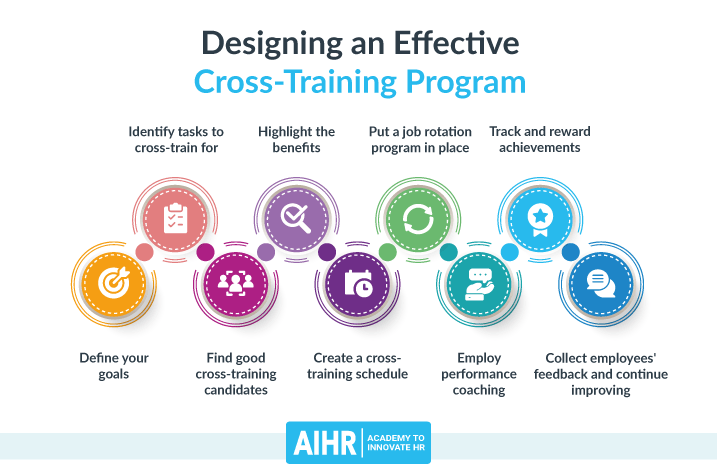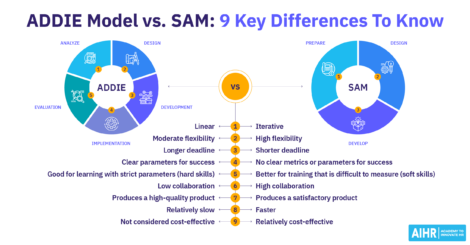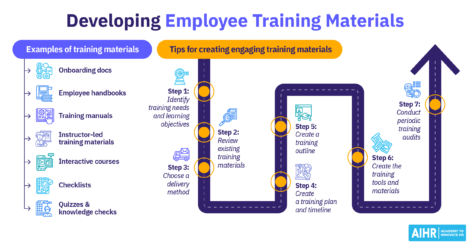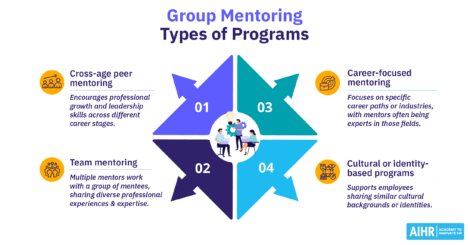Cross-Training Employees: 9 Practical Tips for Your Organization

Cross-training employees has many benefits for organizations and employees, improving organizational performance and helping companies prepare for both the expected and the unexpected. Not only can it make your employees more effective and productive, but it can also improve the versatility of your organization and boost your bottom line. Let’s have a look at cross-training and how to implement it in more detail!
Contents
What is cross-training in the workplace?
What are the benefits of cross-training employees?
Drawbacks of cross-training
How to design an effective cross-training program
What is cross-training in the workplace?
Cross-training is the practice of training an employee to be able to do the work that another employee does, in addition to their primary job role. For example, person A is trained to do the tasks that person B usually does and vice versa.
Cross-training main objectives are to:
- increase an employee’s skill set,
- increase flexibility within the organization,
- and help everyone better understand how the business operates on all levels.
Cross-training centers on pinpointing the major tasks and operations within the company and ensuring multiple employees can perform these tasks and step in as and when needed. This empowers everyone in the organization and increases their value.
Cross-training is a strategy that can be used across almost all industries and positions.
A real-life example of cross-training in action is at a world-leading design firm, IDEO, famous for its innovative culture and cross-disciplinary approach. CEO Tim Brown was instrumental in creating “T” shaped employees in the company. These are employees who are experts in one area (the vertical stroke of the “T”) but also have a solid working knowledge of multiple other aspects of the business (the horizontal stroke). They meticulously screen for collaborative and empathetic characteristics during the interview process and hire numerous interns to get to know them before hiring.
What are the benefits of cross-training employees?
Cross-training employees benefits everyone in an organization: leaders, managers, and all team members across all departments.
Here is a non-exhaustive list of its benefits.
Enabling flexibility and agility
Cross-training programs increase your employee’s skill sets and may uncover hidden talents. This makes them better prepared for what may arise. For example, if another employee falls ill suddenly, an employee who handles a major business function quits, or if you’re looking to fill a promotion. Your organization will be far more flexible and sustainable, thanks to cross-training.
Improved efficiency
Identifying the essential tasks and skills required for the business to operate optimally requires managers to get clear on what’s most important and how to pass this knowledge along to other employees. This leads to increased efficiency across the business. Employees will have the skills they need to perform no matter what unforeseen circumstances arise.
Better team collaboration
When employees understand each other’s roles and responsibilities, they can better empathize with their colleagues and collaborate and communicate more effectively. Multinational companies, including Facebook and Microsoft, all look for empathy as a trait within their employees because they know how vital this is in creating a collaborative culture.
Learning by doing
The approach of cross-training employees is to show them the skills they need to perform various roles or functions and give them the time and space to put those skills into action immediately. The majority of us learn best by doing, which is why cross-training is such a successful method.
Increased internal mobility
As your employees have greater skill sets, this provides them with potential new career paths within the organization.
Bruce Hayward (president at Commodore Technology) notes that cross-training employees also aids succession planning and succession management. Managers can gain a clearer picture of which employees are best suited to which roles. They help the workers develop their skills, take on additional responsibilities, and reward them with a promotion should the right one arise.
Great return on investment
Multiple studies have shown that cross-training reduces employee turnover and improves retention rates. Stephen Maclaren (Head of Regional Sales Employee Benefits at Al Futtaim Willis) suggests the approximate cost of a new hire averages $30,000, while the cost of continuously training an employee is just $1,500. This means that cross-training can provide organizations with a great return on their investment.
Motivating and engaging employees
Cross-training also makes your employees feel more valued because they’re being invested in. It also increases their job variety (and therefore interest) and helps them recognize there are opportunities for internal progression. This leads to higher levels of engagement and motivation amongst workers.
Drawbacks of cross-training
Although the benefits are vast, there are some potential drawbacks of cross-training that you need to be aware of.
Negative perceptions by employees
Suppose you don’t present your cross-training program in the right way. In that case, there’s a danger of your employees believing they’re being asked to increase their workload and responsibility without any financial benefits.
Struggling to balance the workload
Cross-training involves learning new skills and performing new roles. This can be a challenging process, especially when employees have to balance this with their existing workload. Organizations must ensure they prevent employees from becoming overworked and overwhelmed; otherwise, you risk losing them.
Loss of focus
Another risk of cross-training is that employees become generalists and lose their specialized skills or knowledge.
How to design an effective cross-training program
Now that you understand cross-training employees’ pros and cons, let’s explore how to design an effective cross-training program in your organization.
Define your goals
The first step to creating an effective cross-training program is to define what your goals are.
Is your goal to increase job satisfaction and engagement or to create a contingency plan for a specific role? And which teams or departments need cross-training the most?
Jen Rossi at ECBM Insurance suggests focusing on the teams that most urgently need cross-training first. For example, understaffed teams, teams that have the newest, most inexperienced employees, or those who actively want to cross-train.
Identify tasks to cross-train for
A job analysis is a process that breaks down one job into smaller components. Each of these is analyzed to describe the tasks and skills involved in the job. This can be conducted by employees, managers, or OD or HR professionals.
Conducting a job analysis will help you identify the critical tasks you need to cross-train for in any given role. This will help you stay focused on the most important tasks and leave less urgent ones for later.
Find good cross-training candidates
Not all employees will be a naturally good fit for cross-training. For this reason, it’s vital that you analyze performance data to find the best cross-training candidates.
Consulting agency Intek Solutions encourages employers to be careful in their selection of employees to be cross-trained, as well as the specific skills they will be taught. This is because some employees are eager to master new skills while others are happy where they are and cannot handle more.
Be sure to talk to your employees before making any decisions. Are they open to cross-training? Are they excited by it? And what do they want to learn?
Highlight the benefits
To get your employees on board with cross-training—and prevent them from viewing it as a larger workload without any financial rewards—it’s important to highlight the benefits to them.
Show your employees the benefits in terms of enrichment and development for their careers and make it fun and engaging. For instance, you can create introductory videos for your cross-training program. This will get them excited and motivated to learn. Without this, there is no incentive for employees to embrace cross-training.
Create a cross-training schedule
The next step is to create a schedule for employee training to take place. It’s essential that you consider your employee’s current workload and respectfully build in training around this.
As an organization, you want your employees to be as productive as possible and keep your costs as low as possible. However, this needs to be balanced by ensuring your employees are happy at work and not at risk of stress or exhaustion—this will only lead to demotivation, periods of absence, or employees quitting.
This is why you must create boundaries. Set time commitments and expectations from the outset, and ensure this feels manageable to everyone involved. Even an hour of training each week can amount to a lot over a few months.
Put a job rotation program in place
Job rotation refers to moving employees periodically between roles within an organization. Usually, these jobs are temporary and will all be on the same level and are therefore not considered promotions.
Setting a specific period for employees to spend in different jobs and learn the basics is a great way to build their knowledge and competencies, reduce boredom, increase motivation, and a collaborative mindset.
Let’s take a sales assistant in a department store as an example. You might initially train that employee in their designated department and then let them spend one day each week in a different department to understand how they operate. Your sales assistant’s primary function might be to handle sales at the cash register. Still, you might also want them to understand other parts of the business, including the stock warehouse, managing stock levels, designing and merchandising the shop floor layout, weekly and monthly budgets, and forecasts.
Ensure this temporary cross-training period is long enough for employees to gain the skills they need and brief enough so they can get back to their primary function and what they do best. This helps you reduce the potential risk of employees becoming generalists and losing their specialist skills.
Employ performance coaching
Performance coaching is a type of on-the-job learning and development. It involves managers working with and nurturing their employees each day, as well as peer-to-peer learning. To help your managers become effective coaches, you need to give them training in being effective mentors.
A compelling example of performance coaching is when an employee watches their manager answer and close a sales call. They can pick up on subtle language choices and actions that help them develop their skills. Performance coaching can also happen in reverse of this, where a manager watches an employee in action and then offers valuable feedback and advice.
If you want to create a coaching culture, your employees need to trust each other, be willing to work together (regardless of hierarchy), and have a growth mindset.
The key to ensuring your managers excel at coaching is to allow them to experience the coaching process first. They cannot teach something they don’t know.
Track and reward achievements
Tracking achievements will help you assess how effective your cross-training program is and where you need to adjust your approach.
When it comes to rewarding employees for their achievements, some may already feel rewarded by being able to continue learning and developing and having the opportunity to put those new skills into practice.
Use performance reviews as a way to track employee’s development, and be sure to reward your highest performing employees with bonuses, raises, and even promotions where you see fit. This removes the possibility of employees feeling like they’re being overworked without any rewards and motivates them to continue learning.
Collect employees’ feedback and continue improving
Collecting feedback from employees involved in cross-training programs should be an ongoing process. Use what you learn to make adjustments accordingly and make your program more effective.
For example, you may find that a certain program is too time-consuming or doesn’t provide employees with the skills they need to effectively perform in a different role.
Feedback like this is valuable, and it’s essential that you continue asking for it and acting on your findings.
Cross-training employees centers on effective planning and striking the right balance
The key to cross-training your employees is to know what you want to accomplish and make sure your workforce is on board from the start. Continue improving your program, and you’ll create a team of multi-skilled employees who are invaluable to your business.
We live in a world where markets are constantly shifting, and skill requirements change accordingly. Therefore, creating and implementing a cross-training program is essential for every organization that wants to enjoy growth and success today and in years to come.
Weekly update
Stay up-to-date with the latest news, trends, and resources in HR
Learn more
Related articles
Are you ready for the future of HR?
Learn modern and relevant HR skills, online













